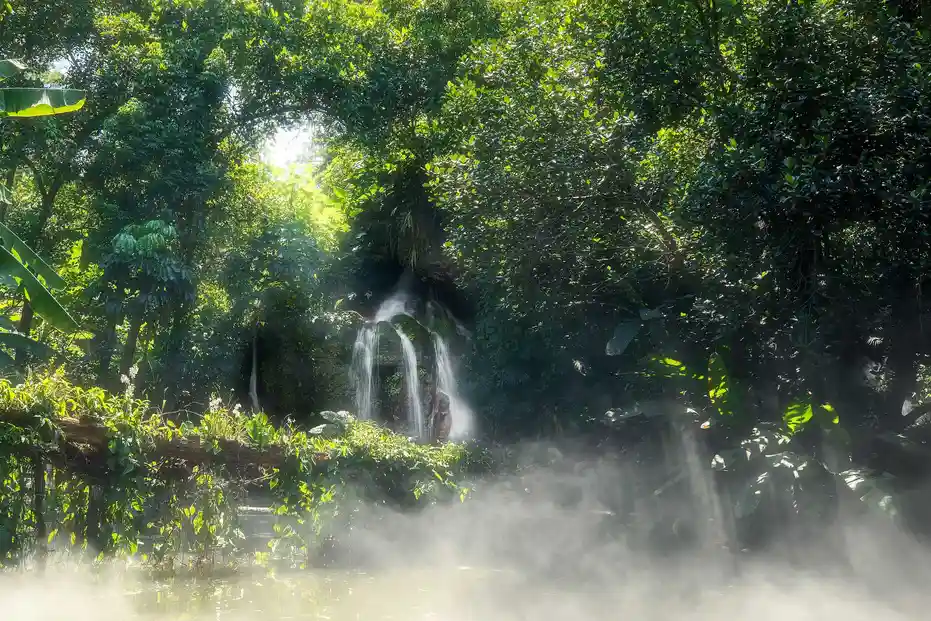Discover the Natural Beauty of Xiamen’s Green Oasis
If you’re planning a trip to southeastern China, one destination stands out for nature lovers and curious travelers alike: a lush sanctuary tucked into the hills of Xiamen Island. This urban retreat offers more than just scenic views—it’s a living museum of plant life, cultural history, and peaceful escape from city noise.
The site blends tropical landscapes with traditional Chinese garden design. Visitors walk beneath towering palms, cross stone bridges over lotus ponds, and explore themed zones that span continents. Whether you’re a botany enthusiast or simply seeking tranquility, this destination delivers on every level.
In this comprehensive guide, we’ll cover everything you need to know before visiting. From opening hours and ticket prices to hidden trails and seasonal highlights, you’ll get practical tips and insider insights. Our goal is to help you make the most of your experience in one of Fujian Province’s most celebrated green spaces.
What Makes This Garden Unique?
Unlike typical city parks, this attraction was designed with both conservation and education in mind. Opened in 1969, it covers over 4.9 square kilometers and houses more than 5,000 plant species. Its location on Wanshi Mountain gives it elevation changes that enhance biodiversity.
The area includes specialized gardens such as succulent collections, fern valleys, and medicinal herb plots. Each section is carefully curated to reflect ecological zones found across southern China and Southeast Asia. The layout encourages slow exploration, rewarding visitors who take their time.
One standout feature is its integration of historical architecture. Ancient pavilions and rock carvings coexist with modern greenhouse facilities. This blend creates a layered experience—part botanical exhibit, part cultural journey.
How to Plan Your Visit to Xiamen Botanical Garden
Planning ahead ensures a smooth and enjoyable experience. The garden is open daily from 6:30 AM to 6:30 PM, though last entry for paid areas is usually at 5:30 PM. Arriving early helps avoid crowds and enjoy cooler temperatures.
Admission fees are affordable by international standards:
| Ticket Type | Price (CNY) |
|---|---|
| General Admission | 30 |
| Student/Senior | 15 |
| Children (under 1.2m) | Free |
| Greenhouse Access | +10 |
Wear comfortable shoes—the terrain includes slopes and unpaved paths. Bring water, sunscreen, and a hat, especially during summer months. While food stalls exist near the entrance, packing a light snack allows for spontaneous picnics under shady groves.
Must-See Zones Within the Garden
With so much ground to cover, focusing on key attractions makes sense. Here are five zones no visitor should miss:
- Tropical Rainforest Conservatory: A climate-controlled dome simulating equatorial conditions. Features hanging vines, waterfall displays, and rare orchids.
- Succulent & Cactus Garden: One of the largest collections in southern China. Includes agaves, aloes, and endemic desert species.
- Lake & Lotus Pond Area: Ideal for photography. Surrounded by willow trees and wooden walkways.
- Bamboo Grove: A serene path lined with multiple bamboo varieties. Often used for tai chi and meditation.
- Herb Garden: Displays plants used in traditional Chinese medicine. Informative signs explain uses and preparation methods.
Each zone tells a story about adaptation, utility, or aesthetic value. Many include QR codes linking to audio guides or detailed species information in English and Mandarin.
Exploring the Xiamen Botanical Garden Conservatories
The indoor conservatories offer climate-controlled environments ideal for delicate or non-native species. These glass structures protect sensitive flora while allowing close observation.
The main greenhouse has three sections:
- Orchid Room: Home to over 300 orchid species, including native Dendrobiums and imported Phalaenopsis.
- Fern House: Mimics high-humidity forest understory. Features tree ferns and moss-covered logs.
- Desert Pavilion: Showcases drought-resistant plants from Africa and the Americas.
Visitors often spend 30–45 minutes here. Photography is permitted, but flash may be restricted in certain areas to protect light-sensitive plants. Staff members are available to answer questions about propagation techniques and conservation efforts.
Best Times to Visit for Optimal Experience
Timing affects crowd levels, weather, and blooming cycles. Spring (March to May) is widely considered the best season. Cherry blossoms, azaleas, and camellias reach peak bloom during these months.
Summer brings heat and humidity, which can make walking strenuous. However, lotus flowers bloom in July and August, creating stunning visual displays around the central lake.
Fall offers milder temperatures and fewer tourists. It’s also harvest season for many fruit-bearing plants on display. Winter sees reduced foliage, but the evergreen collection remains vibrant.
Avoid national holidays like Golden Week (October 1–7), when local travel surges. Weekdays between 9 AM and 11 AM typically provide the quietest experience.
Nature Trails and Walking Paths at Xiamen Botanical Garden
The garden features over 15 kilometers of marked trails. Routes vary in difficulty, from flat boardwalks to steep hillside climbs. Trailheads are clearly labeled with estimated duration and elevation gain.
Popular routes include:
- Lotus Loop – 1.2 km, easy, paved path circling the main pond.
- Canopy Walk – 2.1 km, moderate, elevated bridge through treetops.
- Summit Trail – 3.5 km, challenging, leads to panoramic viewpoint.
Maps are available at entrances and online. Consider downloading the official app for GPS navigation and real-time updates. Benches and rest areas are spaced every 500 meters. Wildlife sightings—such as bulbuls, kingfishers, and monitor lizards—are common along quieter paths.
Cultural Highlights Near the Garden Entrance
Beyond plant life, the area surrounding the main gate holds historical significance. A Ming Dynasty temple dedicated to Linzhen Niangniang, a sea goddess, sits just outside the northern boundary.
Inside the garden, several stone inscriptions date back centuries. Calligraphy panels feature poetry praising nature’s beauty. These elements enrich the visit by connecting ecology with heritage.
Regular cultural events take place near the amphitheater zone. These include tea ceremonies, ink painting workshops, and seasonal festivals. Check the event calendar before your visit—you might catch a live performance or guided meditation session.
Tips for Photographers Visiting Xiamen Botanical Garden
Natural light filters beautifully through the canopy, making mornings ideal for photography. Use a polarizing filter to reduce glare on water surfaces and enhance leaf textures.
Key photo spots include:
- Reflections on the lotus pond at sunrise
- The spiral staircase inside the modern greenhouse
- Colorful flower beds near the visitor center
- Architectural details of traditional pavilions
Drones require prior permission due to conservation rules. Handheld shooting is encouraged, and tripod use is allowed if it doesn’t block pathways. Always respect signage asking visitors not to step off designated paths.
Conclusion: Make the Most of Your Trip
The Xiamen Botanical Garden offers a rare combination of natural beauty, educational depth, and cultural richness. It’s more than a park—it’s an immersive experience into the relationship between people and plants.
To maximize your visit, arrive early, wear appropriate footwear, and focus on one or two zones if time is limited. Don’t rush; some of the best moments happen spontaneously—a butterfly landing nearby, sunlight breaking through clouds, or a quiet bench overlooking a valley.
For future trips, consider returning in different seasons to witness how the landscape transforms. You might also explore nearby attractions like Hulishan Fortress or Nanputuo Temple to extend your day.
Whether you’re a local resident or international traveler, this green haven deserves a place on your itinerary. With thoughtful planning and curiosity, your visit can become both memorable and meaningful.



